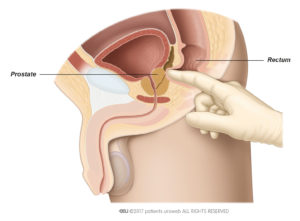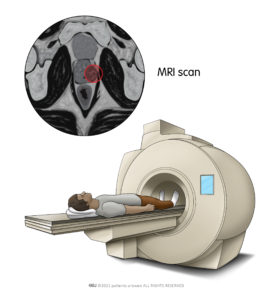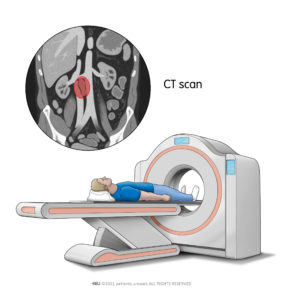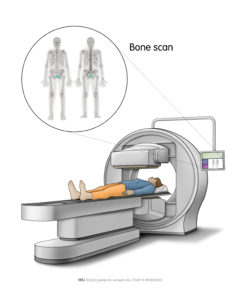Table of Contents [hide]
What checks and tests are available for prostate cancer?
While you may have heard about “screening” for cancer, for example, mammograms to check for breast cancer, not all countries have a prostate cancer screening programme. For this reason, it is very important to get a prostate check if you have any of the known symptoms or family history of prostate cancer.[/vc_column_text][/vc_column][/vc_row]
Digital rectal examination (prostate check)
A prostate check, or digital rectal examination, is a quick and simple test to see if you might have a prostate problem. It involves your doctor inserting a gloved and lubricated finger into your back passage (rectum) to feel your prostate. We realise this might seem embarrassing, but the examination is over very quickly. You may be aware of some pressing and get a brief urge to pass urine, but the examination itself is not usually painful.
Prostate-specific antigen (PSA) test
Prostate-specific antigen or PSA is a protein produced only by the prostate. A PSA test is a simple blood test that measures the amount of PSA protein in your blood. It can help to diagnose or rule out prostate cancer as a cause of your symptoms. If PSA levels in the body are high, it could be a sign that something abnormal is happening in the prostate. High PSA levels do not mean you have prostate cancer, but high PSA levels should be investigated to rule out prostate cancer.
If PSA levels in the body are high, it could be a sign that something abnormal is happening in the prostate. Read more or Download our PSA testing leaflet for more information.
What happens if you are ‘at risk’ of prostate cancer?
There is no single test for prostate cancer. Your doctor will discuss the available tests with you and use the results to see if you are “at-risk” of having prostate cancer.
Your risk is based on several factors, including your PSA level and the results of your prostate examination, as well as your age, family history, and ethnic group. If you are “at risk,” you should be referred to a hospital to discuss further tests. Such tests might include an ultrasound, CT scan, MRI scan, or bone scan.
MRI
Magnetic resonance imaging, or MRI scan, creates pictures of the inside of your body using magnets and radio waves. An MRI scan provides a detailed look inside your prostate. The results will help your doctor decide if you need to have a biopsy. It may also help your doctor find out if any cancer cells have spread to other parts of your body.
During the MRI scan, you will be asked to lie on the scanner bed. The scan itself can take some time (30 to 40 minutes) to complete. The bed will move into the scanner, which is like a narrow tunnel. There is a 2-way intercom inside the scanner, so you will be able to communicate with the radiographer the whole time. You will also be given a device to hold in your hand with a panic button. If you feel anxious during the scan, just let the radiographer know by pressing the button.
The scan itself is painless, but it can feel uncomfortable as you have to lie very still. It is also very noisy inside the scanner, and you will be given ear defenders to wear. Some people find it claustrophobic inside the scanner and have said wearing a sleep mask helped ease their fear.
You may need to have an injection of dye, called a contrast. The dye helps tissue inside your body show up more clearly on the scan. This is usually given via a cannula in your arm. You may feel the dye passing through your veins as either a warm or cold sensation. Some men have said it feels as though you will lose bladder control. So although this won’t happen, it can feel uncomfortable, but it is not painful.
CT scan
Computed tomography, or CT scan as it is commonly known, uses x-rays taken at different angles.These x-rays are sent to a computer which creates a 3-dimensional (3D) image of the inside of your body. A CT scan does not take very long to complete. The results may help your doctor find out if any cancer cells have spread to other parts of your body. During the CT scan, you will be asked to lie on the scanner bed. The bed moves forwards and backwards through the hole of the scanner. You will be able to communicate with the radiographer the whole time.
You may need to have an injection of dye, called a contrast. The dye helps tissue inside your body show up more clearly on the scan. This is usually given via a cannula in your arm. You may feel the dye passing through your veins as either a warm or cold sensation. Some men have said it feels as though you will lose bladder control. So although this won’t happen, it can feel uncomfortable, but it is not painful.
Bone scan
Your doctor might recommend that you have a bone scan to determine if cancer cells have spread to your bones.
Before the bone scan, you will need to have radioactive dye injected into a vein in your arm or hand. Only a small amount of radioactive dye is used, and it is safe. You will need to wait for 2 to 3 hours for the dye to travel through your veins and into your entire body before the scan itself takes place.
During the bone scan, you will be asked to lie on the scanner bed. The scanner will move very slowly down your body and take pictures. The scanner will pick up any abnormal areas of bone, called “hot spots.” Not all bone abnormalities are cancer, and the scanner may pick up other conditions, such as arthritis.
This can be an extremely stressful time for you, especially waiting for the results. If you are struggling to cope, try not to hide your emotions. Talk to your family and friends. If you have not done so already, speak to your doctor about professional support, such as counselling services or local support groups.
PSMA PET-CT Scan
PET-CT scans use a mildly radioactive drug to show up areas of your body where cancer cells are more active than normal cells. Prostate-specific membrane antigen, or PMSA, is a protein found on the surface of prostate cancer cells. PSMA PET-CT scans look for areas of the body where the PSMA protein is found, showing the presence of prostate cancer cells.
Although PMSA PET-CT scans are not commonly used, there is evidence to suggest that this type of scan is more accurate than others at detecting if your cancer has spread to other parts of the body. In time, PSMA PET-CT scans will likely become the standard scans used to detect the extent of prostate cancer spread throughout the body.
Ultrasound
An ultrasound uses sound waves to send images to a computer. This allows your doctor to see inside your body. An ultrasound of your prostate involves your doctor or a sonographer inserting a lubricated wand-like device, called a probe, into your back passage (rectum).
The examination does not take long. It might feel uncomfortable, but it is not usually painful.
Biopsy
A biopsy of the prostate is the most accurate way of seeing if you have prostate cancer. However, a biopsy involves your doctor using a thin needle to take small tissue samples from your prostate. Because of this, a biopsy is only done when other tests strongly suggest you have prostate cancer.
Biopsy samples are sent to a laboratory where a pathologist looks at them under a microscope to check for cancer cells. The results will help your doctor plan and discuss your treatment options with you.
There are 2 main types of prostate biopsy:
1. a trans-rectal ultrasound biopsy, or TRUS
2. a trans-perineal biopsy
It is important to discuss the risks and benefits of each procedure with your doctor to make sure it is the right one for you.
Trans-rectal ultrasound biopsy (TRUS)
During a TRUS biopsy, your doctor will insert a lubricated ultrasound probe into your back passage (rectum). The ultrasound probe scans the prostate, and an image appears on a screen. The doctor uses this image to guide where to take the biopsy from. You will be given a local anaesthetic to numb the area and minimise any discomfort from the procedure.
Trans-perineal biopsy
Your doctor will insert a lubricated ultrasound probe into your back passage (rectum) to see the prostate during a trans-perineal biopsy. The biopsy needle will then be passed through the skin between the testicles and the back passage. A trans-perineal biopsy is commonly done under local anaesthetic , so the area will be numbed to minimise any discomfort from the procedure. It is becoming more popular because it is thought to have a lower risk of serious infection.





